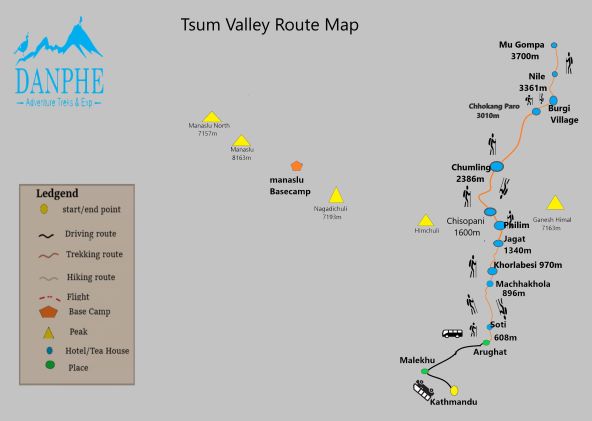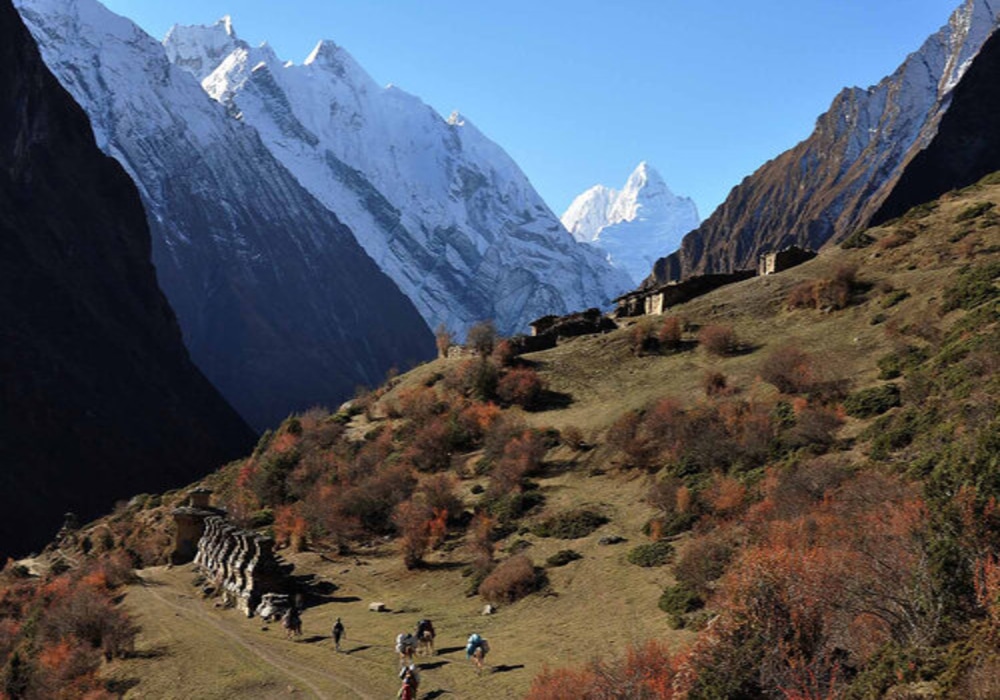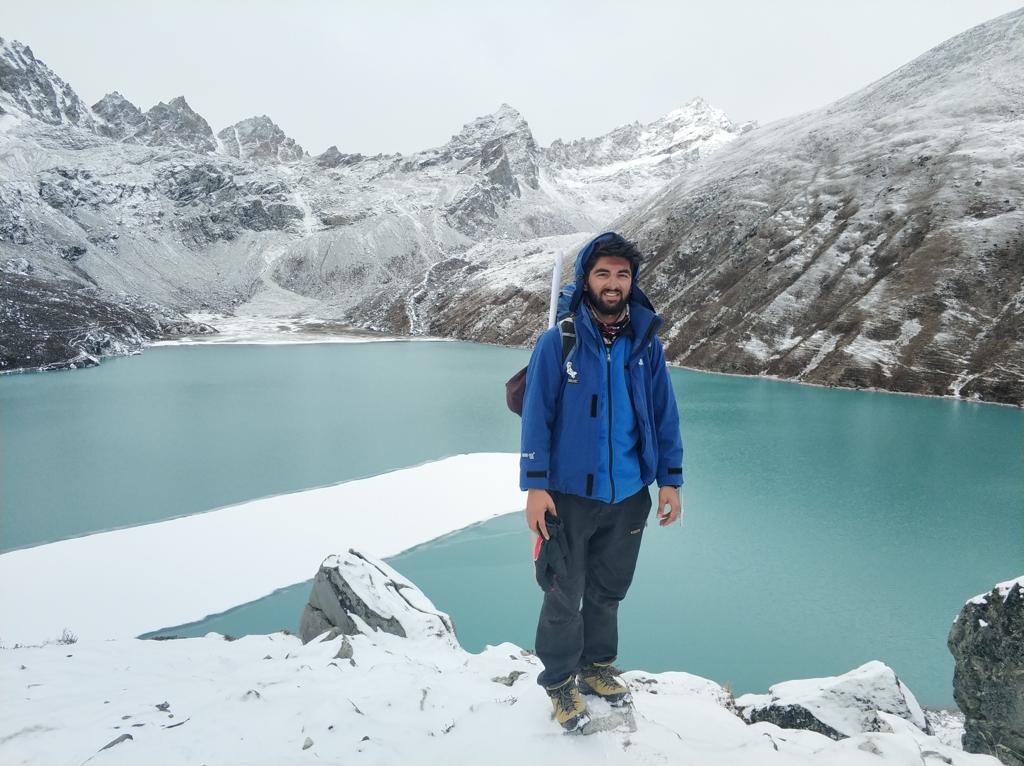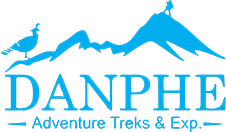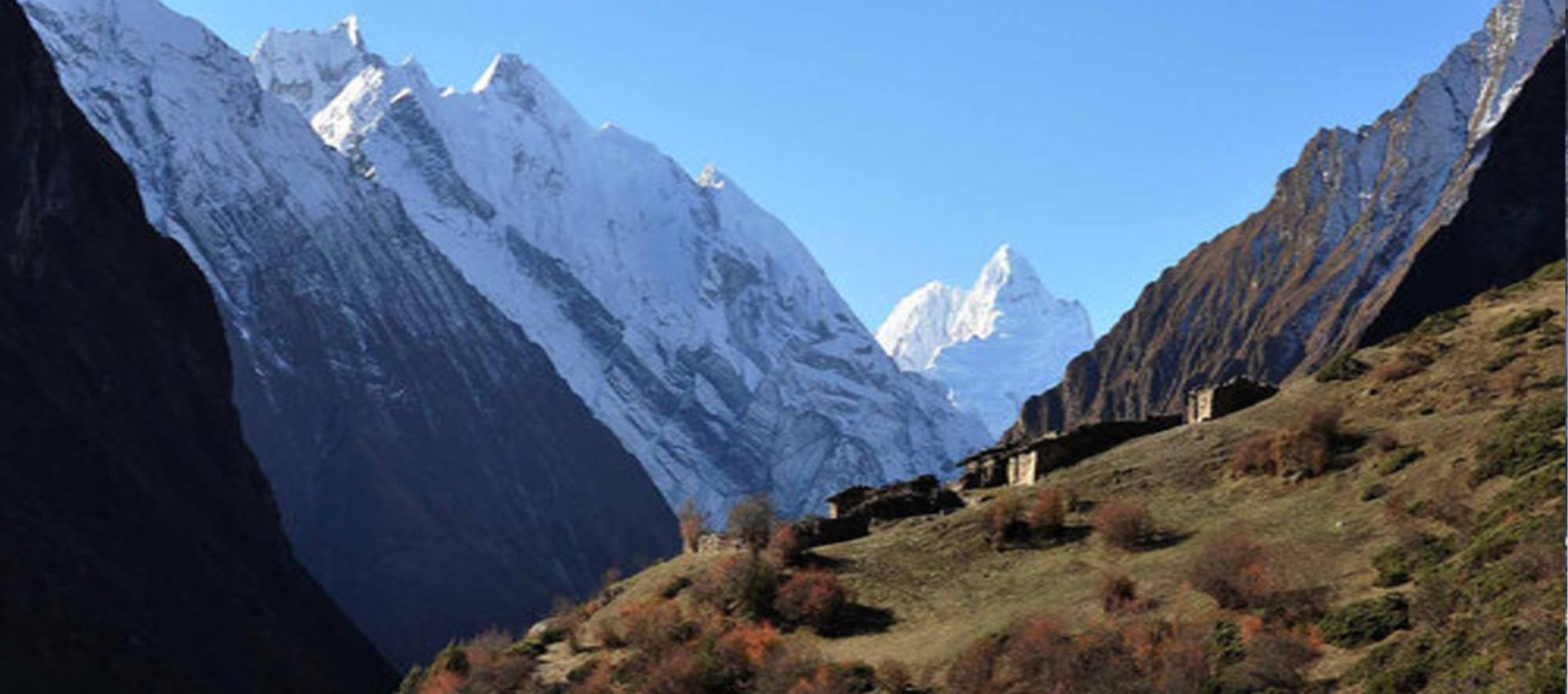Tsum Valey Trek
Tsum Valley is a discreet Buddhist kingdom lying in the secluded corner of the Nepalese Himalaya. The trekking-restricted area was opened for tourists as recent as 2008, hence, the natural wonders of the valley still remain unexplored. Tsum Valley Trek takes you on an adventurous journey on the laps of Ganesh Himal, Shringi Himal, and Boudha Himal ranges. Furthermore, the culture of the valley still retains its authenticity from the ancient practices making the Tsum Valley Trek a cultural study as well.
The 20-day trek begins upon your arrival Kathmandu. Then, Followed a scenic tour to Kathmandu’s most popular UNESCO World Heritage Sites; you’ll depart for Arughat Bazaar lying on the upper hills of the Gorkha district. The trek begins at Arughat and advances north towards the Lower and Upper Tsum. Also a part of the Manaslu trail, you’ll cross numerous traditional villages en route namely Soti Khola, Machha Khola, Jagat, Chisopani, Chumling, Chhokang Paro, and the Nile before resting at Mu Gompa. Mu Gompa is home to the largest monastery in the region and lies close to Tibet in the north. The valley has a long history of Buddhism. As a believed, The Buddhist saint ‘Milarepa” did a meditation in the mountain-caves of Tsum. Kyimu Lung, a popular pilgrimage circuit, also lies inside the valley.
After exploring Mu Gompa and the surrounding places, you’ll begin descending through Burgi, Chumling, Philim, Khorlabesi, and Soti Khola back to Arughat. Milarepa Cave (3700m) is the highest you’ll reach during this trek. The natural trail offers some of the majestic sceneries of the surrounding mountains including Ganesh Himal, Shringi Himal, and Boudha Himal range. The people of the valley are known as ‘Tsumbas’. The rich cultural region is also home to the ancient Buddhist monasteries namely; Rachen Gompa, Mu Gompa, and Dephu Doma Gompa.
At Danphe Adventure Treks, we follow a service pattern that offers maximum ease and security to our clients. The provision of our facilities is also customizable as are the trips across Nepal that we offer. Furthermore, we have tourism experts, seasoned guides and porters for helping you on your journey.
Trip Highlights
- Explore the valley hidden amid the Himalayas, Tsum Valley.
- Witness Tibetan-Buddhist culture of the Tsum and Nubri communities.
- Visit the monasteries like Mu and Rachen gompas which reflect the history and culture of the inhabitants there.
- Take relaxing bath in the natural hot springs at Tatopani.
Trip Itinerary
Expand All
Shrink All
-
Day 01: Arrival in Kathmandu (1300m)
After your arrival at TIA (Tribhuban International Airport), a company representative will transfer you to the trip hotel. You can relax and refresh at the hotel. Later, you participate in a trek briefing at with our members of the company. Overnight stay at a hotel in Kathmandu.
-
Day 02: Sightseeing of Kathmandu valley and Trip meeting
This day entails a brief excursion around the valley of Kathmandu. Exploring the UNESCO world heritage sites, you visit Swayambhunath, Kathmandu Durbar Square, Pashupatinath, and Boudhanath. Apart from being of great religious and historical significance, these sites have set the tone of the city, its people, and their culture. Later, you meet with other members of the trek and make preparations. Overnight stay at a hotel in Kathmandu.
-
Day 03: Drive from Kathmandu to Arughat Bazaar (608 m), Driving duration: 8-9 hours
You’ll drive 126 km northwest of Kathmandu through Prithvi Highway towards Arughat Bazaar in the Gorkha district. The drive takes you along the Trishuli River, large hills, and gorges towards Arughat via Dhading Besi, headquarter of the Dhading district. Arughat is a major town in the area which is divided into two parts by the Budhi Gandaki River. Overnight stay at Arughat.
-
Day 04: Trek from Arughat Bazaar to Soti Khola (700 m), Trek Duration: 5-6 hours
You’ll begin the trek and cross the bridge over Budhi Gandaki towards the western part of Arughat. You’ll pass through the hydro-electric power plant, rice and millet fields en route to Mangaltar and Shanti Bazaar. The trail becomes steeper and more difficult as you cross the Arkhet Khola. From here you’ll descend towards Kuerepani and make way towards Soti Khola. Overnight stay at Soti Khola.
-
Day 05: Trek from Soti Khola to Machha Khola (869 m), Trek Duration: 4 hours
You’ll trek through the beautiful Sal forest towards a ridge above the Budhi Gandaki River. The rocky trail goes up and down through two tropical waterfalls and eventually makes way towards the Gurung village of Lapubesi. You’ll trek along the Budhi Gandaki River and descend to the sandy river bed before climbing a small hill towards Machha Khola village. Overnight stay at Machha Khola.
-
Day 06: Trek from Machha Khola to Jagat (1300m), Trek Duration: 7 hours
Today, you’ll trek through the narrow trail with minor detours and cross the Tharo Khola towards Khorlabesi. After a few more detours, you’ll encounter a natural hot-spring at Tatopani. After crossing Dobhan, you’ll climb the rugged trail to Yaruphant and ascend towards Yaru Khola. After climbing over a ridge you’ll trek along the river and climb towards Jagat village. Overnight stay at Jagat.
-
Day 07: Jagat to Chisopani (1660 m), Trek Duration: 4 to 5 hours
You’ll get your ACAP permit checked at Jagat. Afterward, you’ll climb over a rocky ridge towards Salleri and then descend to Sirdibas. The valley opens up en route to Ghatta Khola. You’ll continue upstream and climb towards Philim, a large Gurung village. After a short hike from Philim, you’ll reach the village of Chisopani. Overnight stay at Chisopani.
-
Day 08: Chisopani to Chumling (2386 m), Trek Duration: 6 to 7 hours
You’ll ascend further north from Chisopani and cross the gorge towards the huge waterfall and the pristine pine tree forests. You’ll descend down the trail leading to Tsum Valley through the lush pine and rhododendron forests. En route Lokpa, you can relish the magnificent views of Himalchuli (7893m) and Boudha Himal range. After crossing the Siyar Khola, you’ll arrive at Chumling. Overnight stay at Chumling.
-
Day 09: Chumling to Chhokang Paro (3010 m), Trek Duration: 4 to 5 hours
Today, you’ll make your way towards the beautiful Buddhist village of Chhokang Paro with the magnificent views of the nearby Ganesh Himal (7422m) throughout the trail. You’ll walk pass Rainjam village towards Sarpu Khola and cross the bridge to arrive at Gho Village. A continuous 2hr uphill hike will bring you to the village of Chhokang Paro. Overnight at Chhokang Paro.
-
Day 10: Chhokang Paro to the Nile (3361 m), Trek Duration: 5 to 6 hours
You’ll ascend further up the Chhokang Paro village towards Lamagaon and cross a suspension bridge to reach the Rachen Gompa, a Nunnery. Pass Siyar Khola, you’ll continue trekking through Lar (micro hydropower), Phurbe, and Pangdun. You’ll witness an old historical Stupa en route to Chhule. After climbing upstream you’ll finally arrive at Nile. Overnight stay at Nile.
-
Day 11: Nile to Mu Gompa (3700 m), Trek Duration: 3 hours
As you’re above the altitude of 3500m, it’s essential to trek at a slower pace. You are now closer to the Tibetan border; hence, you’ll witness Tibetan influenced settlements en route. Short walk west of the valley through the Tibetan-influenced landscape will lead you to Mu Gompa. You’ll pay a visit to the historical monastery. If time permits, you can make a brief visit to the Dephu Doma Gompa. Overnight stay at Mu Gompa.
-
Day 12: Sightseeing and acclimatization at Mu Gompa (3700 m)
Today you’ll spend time exploring the Mu Gompa region. You can observe the rich Tibetan-influenced villages and visit the largest Mu Gompa (Monastery) today. The monastery lies at the altitude of 3700m in the remotest part of the valley. Here, monks practice meditation and Tibetan-Buddhist rituals. You can witness their involvement and also learn about the history and significance of the gompa in the region. Overnight stay at Mu Gompa.
-
Day 13: Mu Gompa to Burgi Village (2386 m), Trek Duration: 5 hours
Here on, you’ll begin descending. You’ll retrace our path and trek back through Chhule and Phurbe villages lying on the eastern bank of Siyar Khola. The 5hr of descend will bring you to Burgi village, a beautiful village in Upper Tsum. You can climb up to the Milarepa Cave (Piren Phu) to catch the magnificent sights of Poshyop Glacier, Kipu Himal, and Chure Himal ranges.
-
Day 14: Burgi village to Chumling (2386 m), Trek Duration: 5 to 6 hours
You’ll trek further down the valley towards the Chumling village. You’ll continue trekking through the lush pine and rhododendron forests to Chhokang Paro. After a brief stop, you’ll continue trekking through Gho and cross Sarpu Khola to reach the other side to Chumling village. At the latter end of the trek today, you reach the outskirts of the Tsum Valley. Overnight stay at Chumling.
-
Day 15: Chumling to Philim (1570 m), Trek Duration: 6 to 7 hours
The trail continues towards Lokpa village. You can enjoy the scenic Samba Falls en route. The trek is moderately easy today as you trek over flatlands. The 6-7hr of trek will bring you to Philim village. Philim serves as the gateway to the Ganesh Himal Base Camp. Overnight stay at Philim.
-
Day 16: Trek from Philim to Khorlabesi (970 m), Trek Duration: 6 to 7 hours
You’ll continue descending along the Dobhan Khola and cross Jagat and Tatopani villages to reach Khorlabesi. A short descent from Sirdibas will bring you to Jagat. A short walk will bring you to Tatopani. If time permits, you can choose to take a dip in the natural hot spring of Tatopani. Further down from Tatopani lies Khorlabesi village. Overnight stay at Khorlabesi.
-
Day 17: Trek from Khorlabesi to Soti Khola (700 m), Trek Duration: 6 to 7hours
You’ll cross the Tharo Khola and make way towards Machha Khola village. A short trek along the Budhi Gandaki River will bring you to Lapubesi. You will trek past the two waterfalls to reach Khursane. After a short walk along the ridge above Budhi Gandaki, the valley opens a trail leading directly to Soti Khola. Overnight stay at Soti Khola.
-
Day 18: Trek from Soti Khola to Arughat (608 m), Trek Duration: 3 to 4 hours
Today is the last day of the trek. You’ll climb the ridge leading towards Kuerepani. A short descent past the waterfall will bring you to Arkhet Khola. You’ll make your way through the lush forests to reach Mangaltar. After passing the hydroelectric plant you’ll finally arrive at Arughat Bazaar. Overnight stay at Arughat.
-
Day 19: Drive from Arughat Bazaar to Kathmandu (1300 m), Drive Duration: 7 to 8 hours
Today, you’ll catch your commute back to Kathmandu from Arughat. You’ll drive along the massive Marsayangdi and Trishuli rivers with the splendid views of lush green hills, mountains, and villages towards Kathmandu. Once at Kathmandu, you can rest in your hotel. If time permits, you also can explore the city and look for gifts and souvenirs while doing so. Overnight stay at a hotel in Kathmandu.
-
Day 20: Transfer to international airport for your final flight departure
What's Included
- Airport Pickups and drops in a private vehicle.
- Hotel in Kathmandu and with breakfast as per the Itinerary.
- Cultural tour at Kathmandu with Guide in private vehicle.
- All meals (Breakfast, Lunch, and Dinner) during the trek.
- All Ground and Air Transportation during the Trek.
- An experienced, English speaking, and friendly guide and Porter (1 Porter 2 trekkers).
- Salary for the staff including their food, drinks, accommodation, and transportation.
- All necessary paper works, Conservation entry permits, and TIMS card.
- An arrangement for emergency helicopter service which will be paid by your travel insurance.
- Sleeping bag, down jacket and trekking map, if necessary,( to be returned after the trek)
- All government taxes, vat, and local taxes.
- Nepal entry visa fee. (You may easily issue the visa upon your arrival at Tribhuwan international airport (Kathmandu). You will require 2 passport size photos & 25 USD.
- International airfare.
- Your travel insurance (compulsory).
- Meals in Kathmandu
- Entry fees for cultural tours.
- Personal expenses (alcoholic, non-alcoholic drinks bar bills, battery charge, extra porter, boiled water shower, etc.).
- Tips for guide, porter and driver
Equipment List
List of Equipments required for Tsum Valey Trek:
Head
- One Warm winter hat/beanie
- One Sun hat
- 1 Headband/buff
- 1 Sunglasses with UV protection
- One Headlamp/ Torch with extra batteries
Upper Body
- Two pairs of Fleece sweaters- one light and one heavier
- Two pairs of quick-drying long-sleeved base layer shirts
- Three pairs of Short sleeve trekking shirts
- One pair of Wind/rainproof Jacket v 1 Down Jacket
Lower Body
- One pair of trekking shorts
- A pair of trekking trousers
- One pair of lightweight thermal bottoms (seasonal)
- Two pairs of trekking pants with Ziff off bottoms
- One pair of fleece or woolen trousers
- One pair of waterproof pants, breathable fabric
Hands
- One pair of lightweight warm gloves
- A pair of poly-liner glove
Feet
- One pair of trekking boots
- A pair of sandals/ trainers (for wearing around the lodges)
- One pair of down booties (great for keeping feet warm)
- Two pair of thin lightweight inner socks
- Two pair of warm woolen or poly socks
- Gaiters (only in winter)
Other
- One Sleeping Bag
- 12 1 Sleeping bag liner (optional)
- 1 pair of trekking poles
- Water purification tablets/Steripen/Drops
- 1 quick drying towel
FAQs
-
What are the visa requirements?
Currently, all the foreign nationalities (except Indians) require a visa to enter Nepal. Visas are obtainable from embassies abroad or on arrival at Kathmandu’s Airport. If getting the visa at the airport be prepared for long queues. You will also need to provide one passport photo and the $50 USD fee for 30 days.
-
What are the physical requirements for Tsum Valley Trek?
Tsum Valley Trek requires you to trek at an altitude of maximum 3700m and up to 5-7 hours per day, with a small 5-7kg bag. We recommended you to train with long hikes and/or a sport of your choice (e.g. jogging).
-
How old do I need to be?
There is no age restriction for doing this trip, but if you are under 16 it will better to trek with your parents. You must be health-conscious during the trek.
-
What is included?
Included:
- Guides and Porters
- Transportation (including airport transfers)
- Accommodation
- Permits & national park fees
- Sightseeing tour in Kathmandu
- All meal during the trek
- Seasonal fruits
Excluded:
- International flights to Kathmandu
- Food – (while you are in City)
- Showers on Trek
- Tips
- Visa fees (typically $50 USD)
- Personal travel/rescue insurance
-
What is the accommodation like?
You will stay in the Hotel while you are in the city of Kathmandu, which is like a 3-star category. The hotel has access to showers and intermittent internet.
But while you are in trekking Tea House/lodges are the place where you spend the night during the trek, which is very basic. The room is pretty small with twin sharing and a common washroom. Some places have squat style toilets, whilst others have a western style. Shower does not always offer warm water and most teahouses will charge you for use of a hot shower.
-
Which meals are included?
Meals will be served as per the menu of the teahouse/lodges. Where you can find a variety of dishes like Indian, Nepalese, Tibetan, Continental, etc, to choose. Tea, coffee, bakery items, snacks, bars eggs, etc can also be found easily.
-
What currency should I take?
The currency used in Nepal is Nepalese Rupees (NPR). You are unable to get NPR outside of Nepal and therefore you will need to exchange money in Kathmandu. The easiest currency to exchange is USD and Euro. You can also withdraw NPR from the ATM but check with your bank about the relevant charges to do this.
-
Is there any bank or ATM facility during Tsum Valley Trek?
No, there is no any facility of ATM during Tsum Valley trek so we recommend trekkers to carry sufficient Nepali currency. You can easily access ATM service in Kathmandu.
-
What kind of problems can arise at a higher altitude during Tsum Valley Trek?
There is huge change of AMS problem i.e. Acute Mountain Sickness problem. It may cause some problem as you trek higher above 3500 meter altitude (11,482 ft.). But don’t worry about that. We have carefully designed our Tsum Valley itinerary with sufficient time for acclimatization and less walking time each day. And our experienced trek guide will be helping you with it.
-
Do I need insurance before the Tsum Valley Trek?
Yes, you need to be insured before the adventure trekking in Nepal from your home country. However we will be always with you taking care of throughout the whole Tsum Valley trek.
-
What should I pack?
Documents
- Passport
- Travel insurance details
- 2 passport photos
- Cash USD
- Credit/Debit Card
Head
One Warm winter hat/beanie.
One Sun hat
1 Headband/buff.
1 Sunglasses with UV protection.
One Headlamp/ Torch with extra batteries.
Upper Body
2 pairs of Fleece sweaters- one light and one heavier
2 pairs of quick-drying long-sleeved base layer shirts
3 pairs of Short sleeve trekking shirts
1 pair of Wind/rainproof Jacket v 1 Down Jacket
Lower Body
One pair of trekking shorts
A pair of trekking trousers
One pair of lightweight thermal bottoms (seasonal)
Two pairs of trekking pants with Ziff off bottoms
One pair of fleece or woolen trousers
Two pair of waterproof pants, breathable fabric
Hands
A pair of lightweight warm gloves
A pair of poly-liner glove
Feet
One pair of trekking boots
A pair of sandals/ trainers (for wearing around the lodges)
One pair of down booties (great for keeping feet warm)
Two pair of thin lightweight inner socks
Two pair of warm woolen or poly socks
Gaiters (only in winter)
Other
One Sleeping Bag
One Sleeping bag liner (optional)
A pair of trekking poles
Water purification tablets/Steripen/Drops
One quick-drying towel
-
What is the best time of year for Tsum Valley Trek?
Tsum Valley Trek is possible for whole year, but the best time to doing this trek is spring season (March to may) and autumn Season (September to November).
However trekking in winter season to chance to see snowfall with magnificent views of mountain, and in monsoon time you will see waterfalls.
